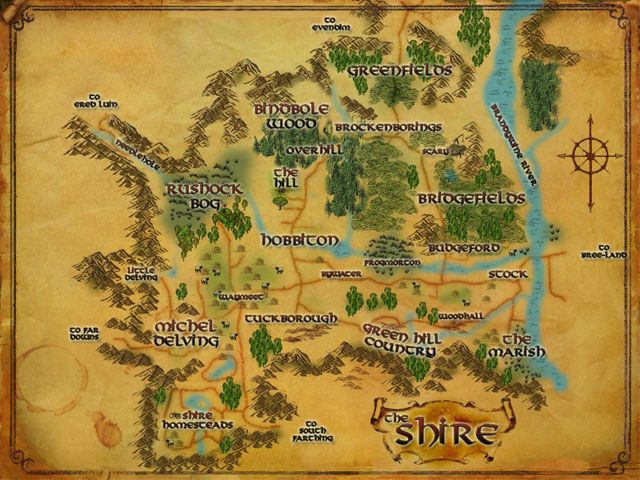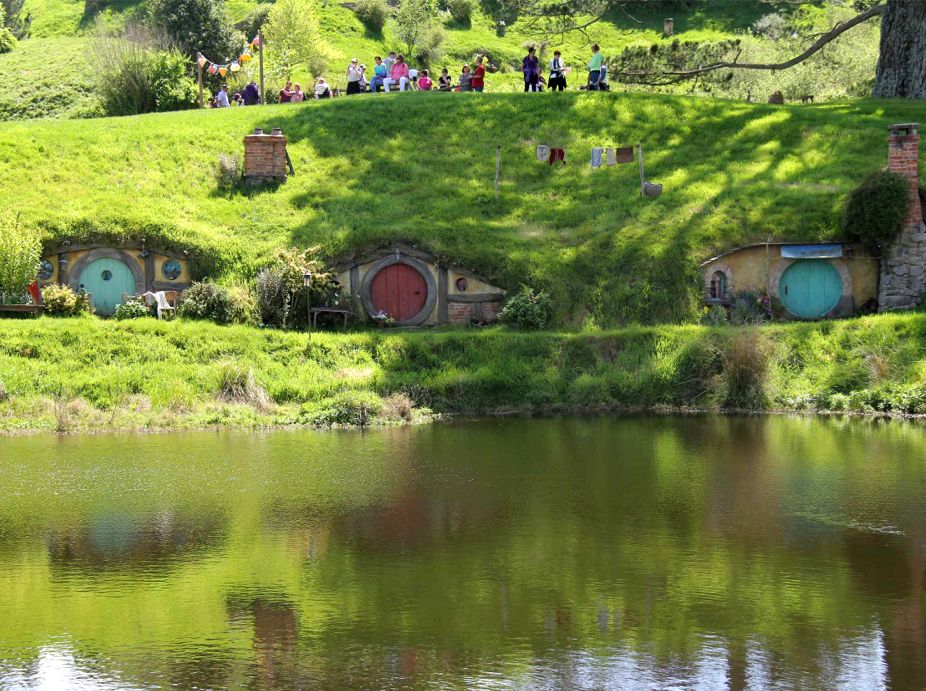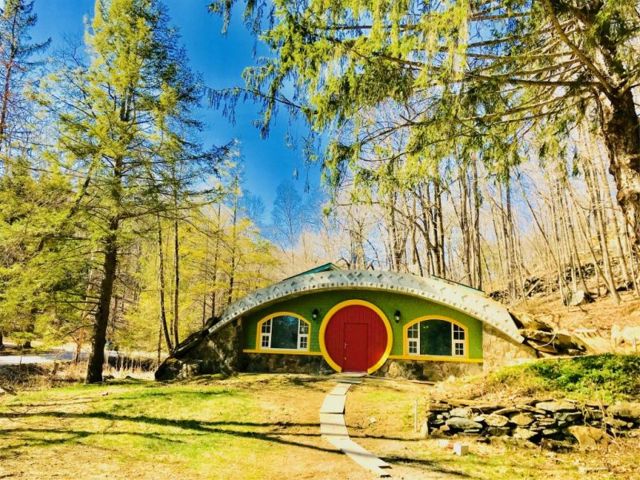All Photos © by Linda S. Velazquez of October 21, 2014 Unless Otherwise Noted

Kia ora – Welcome to New Zealand!
“In a hole in the ground there lived a hobbit. Not a nasty, dirty, wet hole, filled with the ends of worms and an oozy smell, nor yet a dry, bare, sandy hole with nothing in it to sit down on or to eat: it was a hobbit-hole, and that means comfort.” ~ J.R.R. Tolkien, The Hobbit
As a lifelong fan of The Lord of the Rings (LOTR) books and subsequent epic fantasy adventure movies, I naturally was extremely excited when I was in Auckland, New Zealand last October (to speak at a private function organized by Natural Habitats) at the prospect of finally visiting Hobbiton, the movie set located on the North Island where Sir Peter Jackson’s The Lord of the Rings (New Line Cinema) and The Hobbit (Warner Brothers) trilogies were partially filmed.
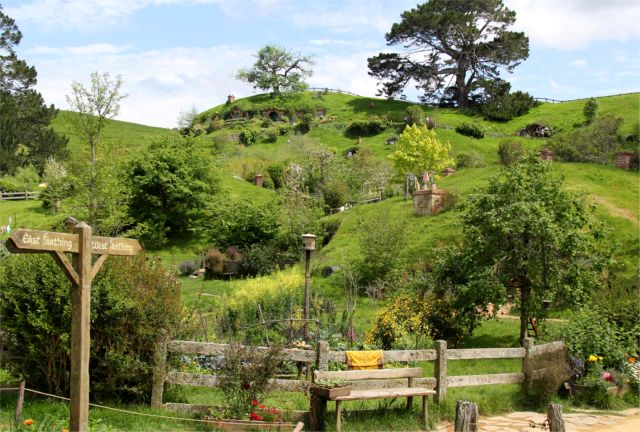
New Zealand, Aotearoa in Maori, is a beautiful, magical country with varied landscapes – gorgeous rocky beaches with stunning shells; lush, oversized vegetation reminiscent of a land of the lost look like throwbacks to prehistoric times; rolling green hills dotted with grazing sheep; magnificent mountains with soaring jagged peaks; stunning lakes; and so much more.
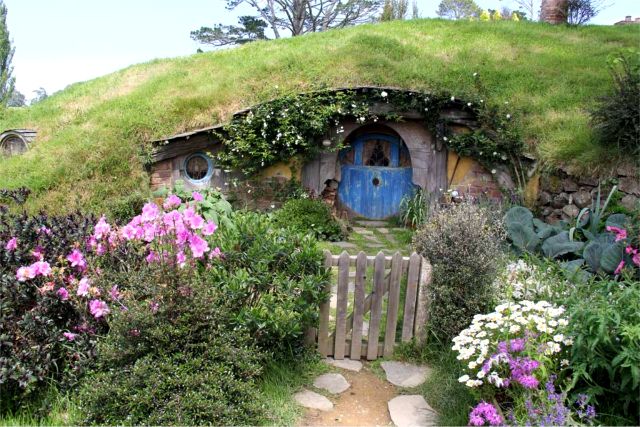
Aramis and I spent about a week here on the North Island with Natural Habitats’ Graham and Louise Cleary as hosts at their lovely coastal home on the Great Barrier Island followed by a couple of days in Auckland where I had the pleasure of speaking to about 100 professionals at The Northern Club, ending in our visit to mythical Hobbiton, the highlight of my trip (Aramis is not the huge fan that I am, however even he loved it!).
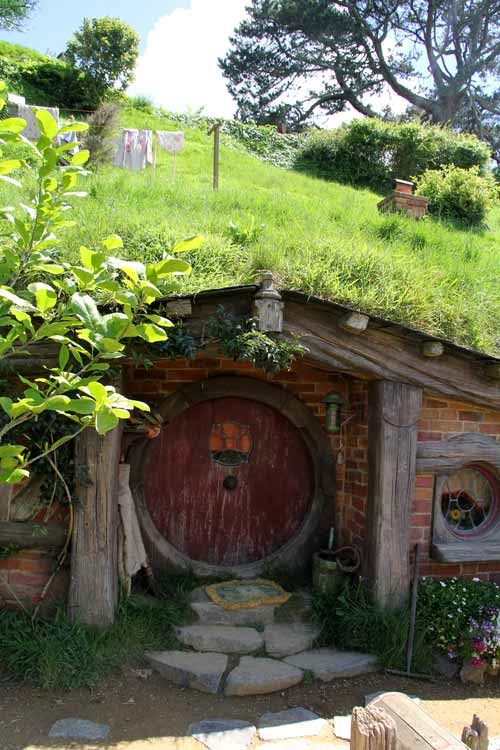
As you may know, our plans to visit the rich Maori heritage culture, see thermal geysers, and explore amazing underground caves filled with glowworms afterwards were cut short by a car accident just after our Hobbiton visit – see my previous post about it. But we would certainly both love to come back to this wonderful country and not only finish our itinerary but venture to the very different landscapes of the South Island, too.
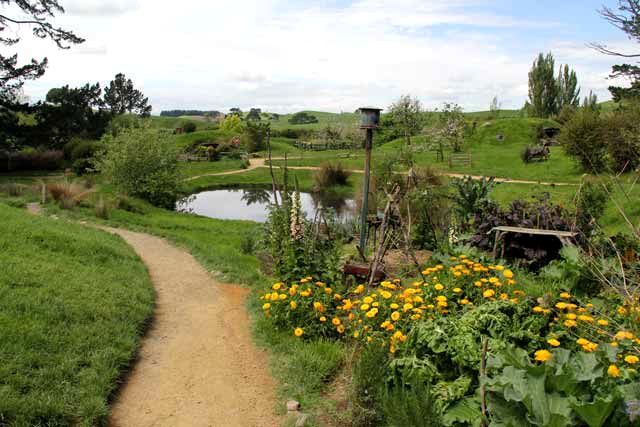
As luck would have it, at the time Graham’s company, Natural Habitats, was creating a greenwall for Peter Jackson and his studio, Wingnut Films Productions Limited. At first he tried to have us visit the project, but timing didn’t allow it…so Graham arranged for a private, behind-the-scenes tour of the Hobbiton™ Movie Set from one of Wingnut Films Productions crew – Brian Massey, the art director, no less, from the LOTR! You can imagine my geeky excitement!
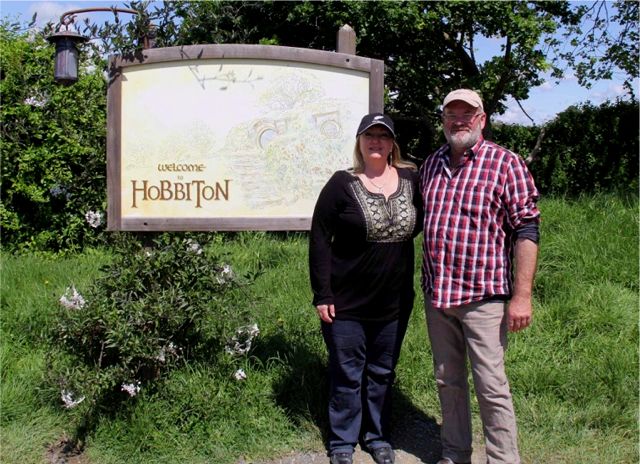
Brian Massey and me at the entrance to Hobbiton within the actual property. Photo by Aramis Velazquez
We met Brian outside the Alexander Farm property on Buckland Road, the commercial entrance to Hobbiton where all the tour buses meet, and we followed him up and around these rugged farm roads populated with lovely baaing sheep on either side. To corral the meandering sheep, I had to keep getting out to close gates behind us after he would open them to get the vehicles through (while carefully avoiding the sheep droppings, which were everywhere).

This photo of Hobbiton Movie Set Tours is courtesy of TripAdvisor
You can see some of beautiful Hobbiton and Brian Massey being interviewed below in the Real Middle-earth Diary 1 (London Premiere) video of The Hobbit: The Battle of the Five Armies by Tourism New Zealand. They had to make and take a Hobbit-hole among other props for the London premiere of December 1, 2014:
Back to the story:
Home of the Hobbits, the Shire is the setting of Tolkien’s vision of Middle-earth and the heart of the Shire, where the author’s fictional realm begins and ends, is Hobbiton.
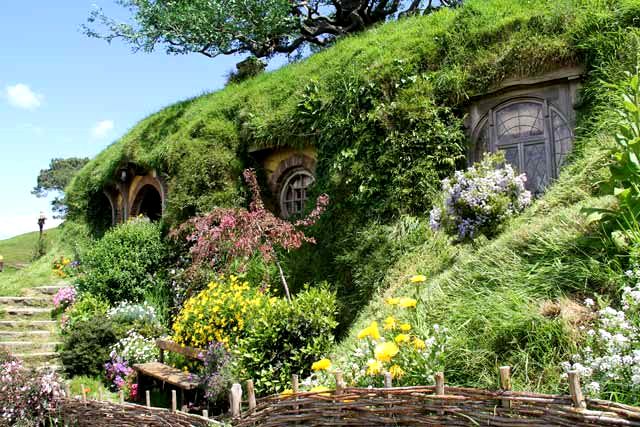
Discovered during an aerial search of the North Island by Dave Comer*, the location scout for Peter Jackson in September, 1998, the 1,250-acre Alexander family sheep (and some cattle) farm setting near Matamata was the perfect location to film the multi-award winning The Lord of The Rings trilogy because of its untouched rolling topography with lakes and huge trees – plus it had the perfect pine specimen for the famous “Party Tree” scene at the beginning of The Fellowship of the Ring during which Bilbo puts on the One Ring and disappears – seen in a bit. Keeping it in the family is Russell Alexander, who is the General Manager at the Hobbiton Movie Set.
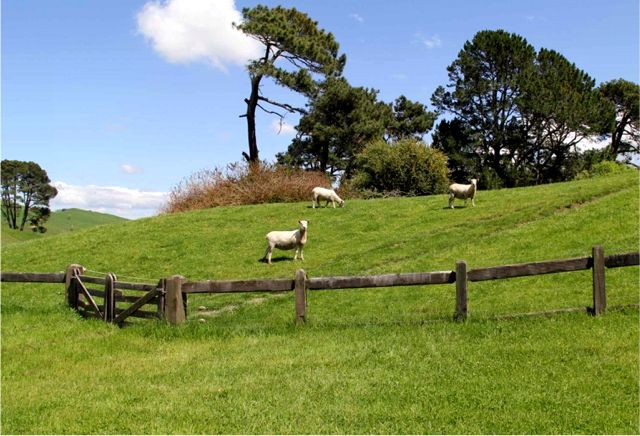
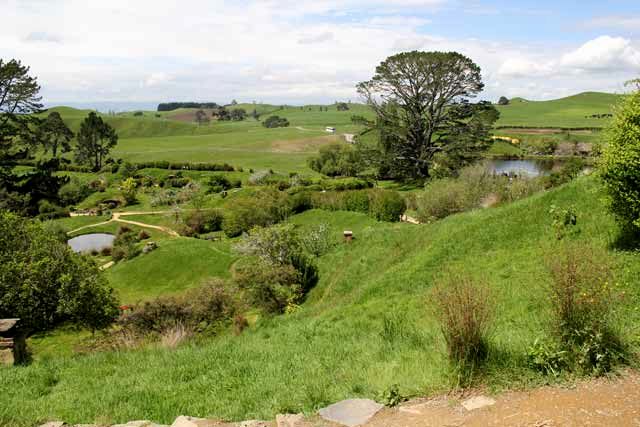
* We are very sorry to hearing of the very recent passing of Dave Comer, who was instrumental in the success of this beautiful setting for the two trilogies. Our condolences to his family as well as his professional family.
With the increasing popularity of the six movies, Hobbiton is arguably one of New Zealand’s foremost tourist attractions, and the only way to access the Hobbiton Movie Set is with a guided tour. Hobbiton tours have been provided since 2002, but have evolved from intermittent offerings from when the original set was temporary to the now highly popular daily tours, seven days a week (except for major holidays) – over 800,000 fellow Tolkien/Jackson fans have visited since its opening.
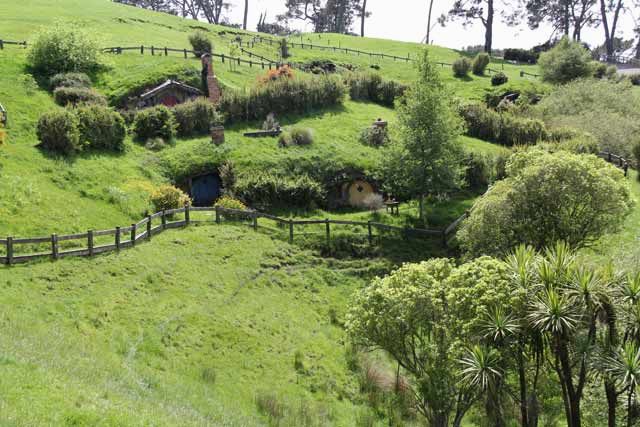
In 1999 the 12-acre site for The Lord of the Rings movies included 37 temporary earth-sheltered smials, or Hobbit holes, created with untreated timber, 7mm ply and polystyrene covered with native turf – a true magical rendition of an idyllic 17th century English country vision of Tolkien’s Middle-earth land of the Hobbits.
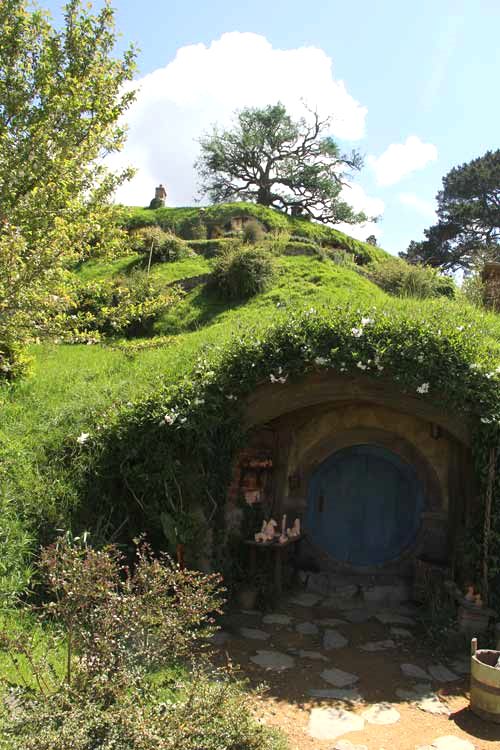
Yet Tolkien’s Hobbit and Elvish societies had a great sensibility regarding the stewardship of the environment, and he took a page from the Scandinavian sod roofs of 1,000 years ago and the much more ancient earth-sheltered Neolithic community structures from about 5,000 years ago when he grass-blanketed the Hobbits’ partially underground homes.
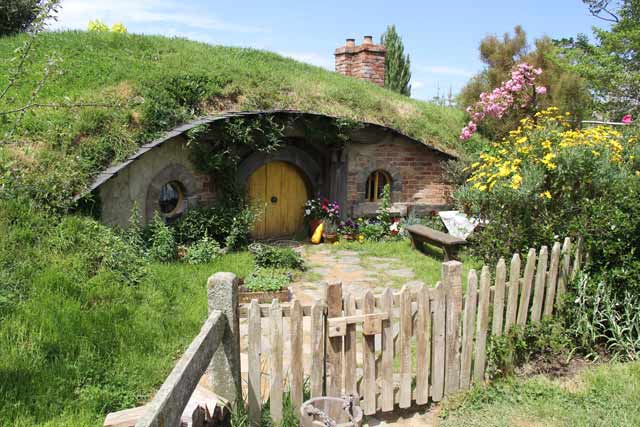
The original set was largely deconstructed after the conclusion of trilogy, leaving empty Hobbit holes. But it was permanently rebuilt in 2011 for Middle-earth 60 years before J.R.R. Tolkien’s The Lord of the Rings saga. Its prequel is The Hobbit trilogy with the feature films The Hobbit: An Unexpected Journey (2012), The Hobbit: The Desolation of Smaug (2013), and The Hobbit: The Battle of the Five Armies – just released this month to huge fanfare.
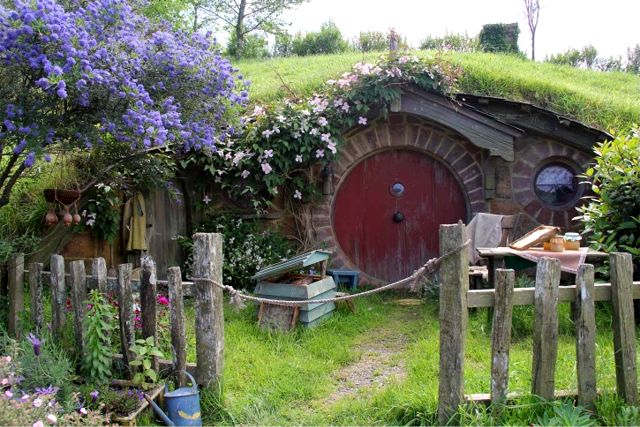
Home of the local Shire beekeeper.
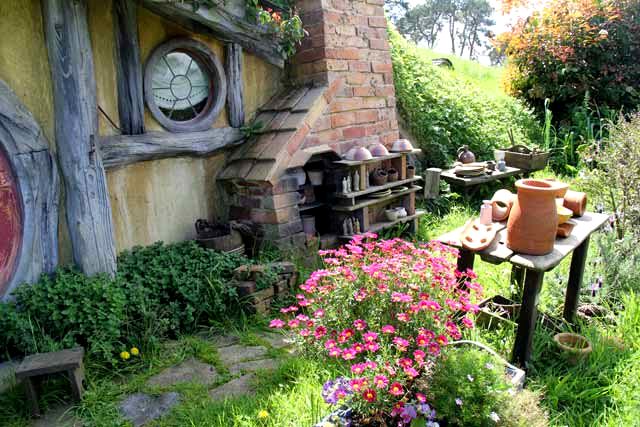
The potter’s abode.
This time, 44 earth-sheltered Hobbit holes covered with native grasses, clover, and wildflowers homes were built into the hills. Although none have finished interiors, each Hobbit home is different and the outward design portrays his or her occupation in the Shire. Only one smial is accessible to enter at the moment, the one below from the home of a gourd artist.
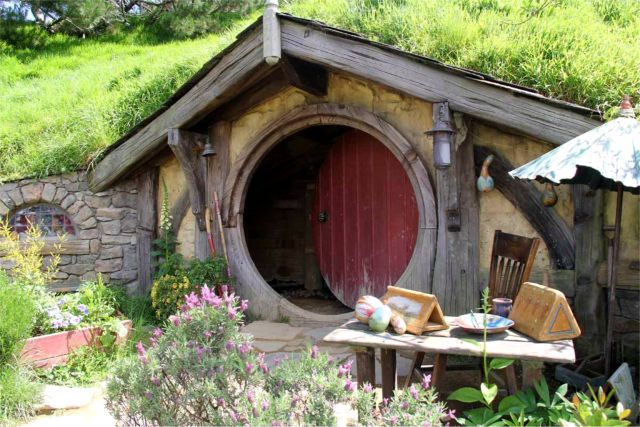
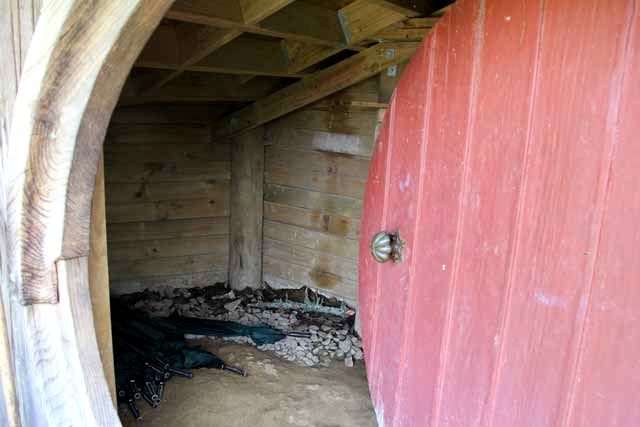
The gourd artist’s smial is currently being used as a storage area for umbrellas.
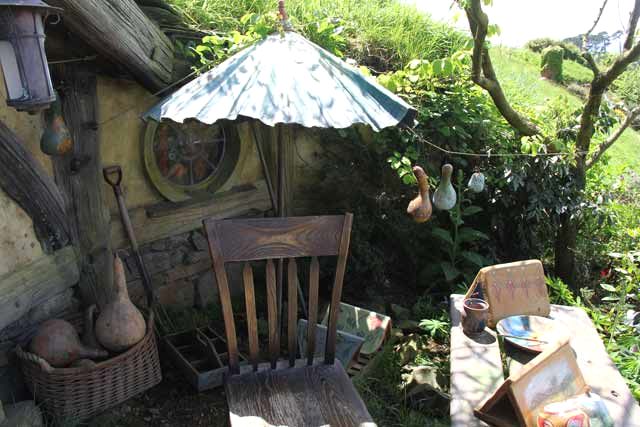
All have real gardens, and a wide variety of vegetables and herbs provide real produce. Each garden has its own distinctive planting design, with profusions of color and beautiful combinations of hues and textures.
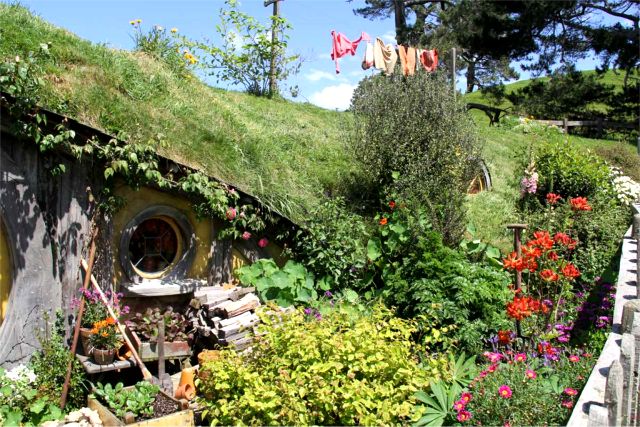
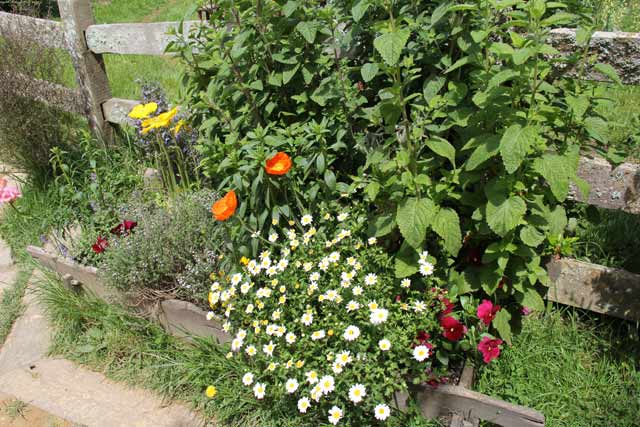
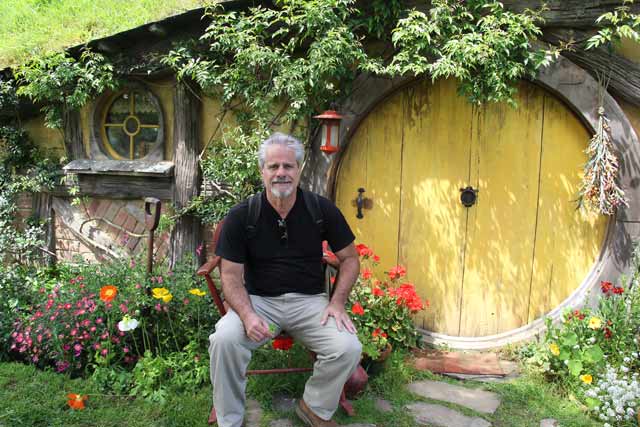
Plus there are other areas specifically dedicated to planting plots. Although it is said that Hobbits prefer a well-ordered and well-farmed countryside, an aura of lazy comfort exudes from the assemblage of these stone buildings, burrows, and overgrown vegetation – and it is designed to feel this way.
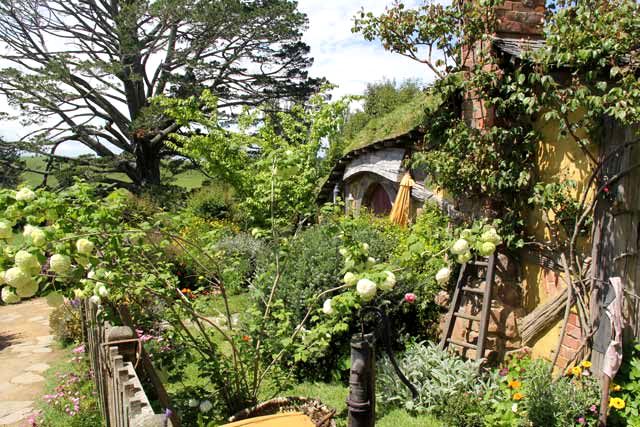
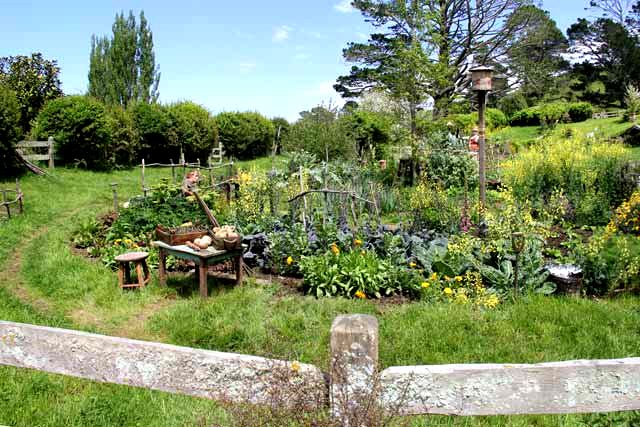
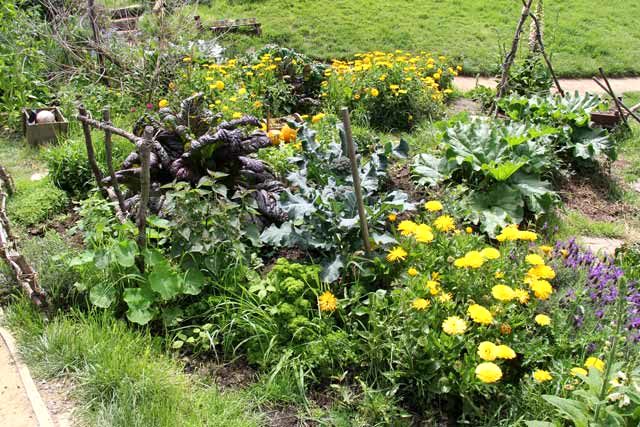
Over 50 individuals staff Hobbiton™ Movie Set on a permanent basis – up to 180 staff over the peak period, including 7 – 8 gardeners during height of season, and 5 in the winter. We saw folks working in the various gardens, and others repairing some thatch on one of the roofs. So we got to hear some secrets and stories of behind the scenes construction and filming from Brian, and we went places others couldn’t go like nursery work areas where staff were preparing to replace some sodded areas and working on a large pine tree.
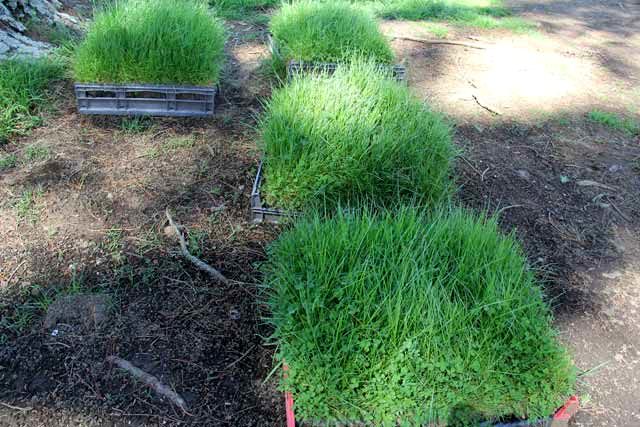
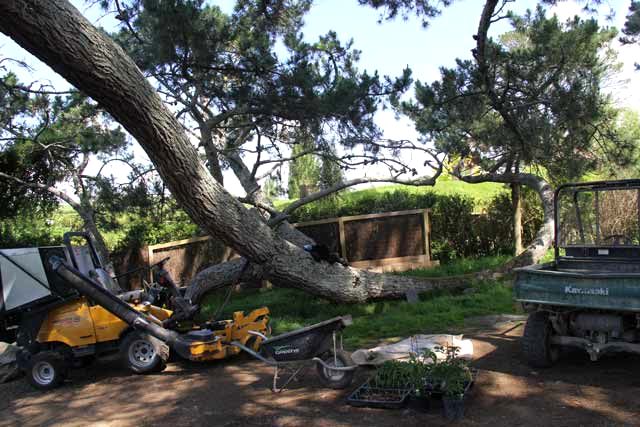
We experienced Hobbiton from the eyes of someone who not only was intimately involved with the site from the beginning as the art director for the LOTR films, but from someone who helps to oversee it to this day – Brian is also Hobbiton’s arborist.
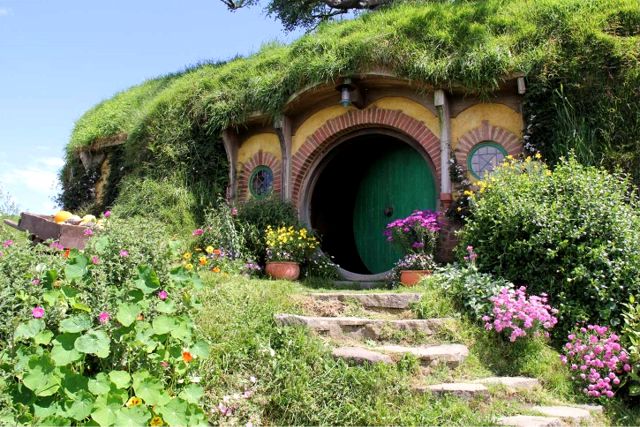
Bag End, home of the Bagginses, the most famous of the Hobbits.
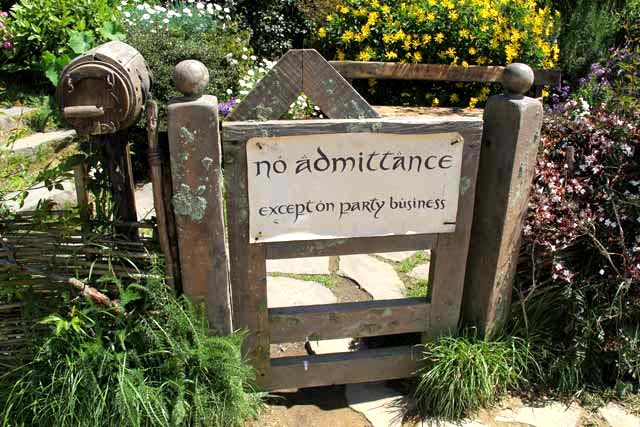
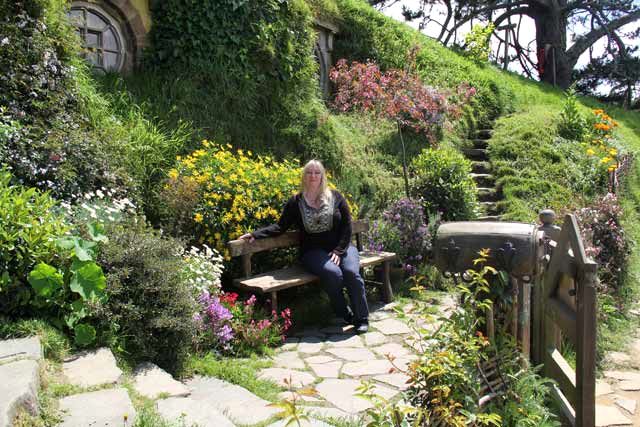
We visited Bag End, the more well-to-do Hobbit hole where protagonists Bilbo and his nephew Frodo Baggins lived (and later friend, gardener and fellow hero Samwise Gamgee and his wife Rosie Cotton) at the end of Bagshot Row, above. We also took a close look at the “reconstructed” oak tree located above Bagshot Row, below.
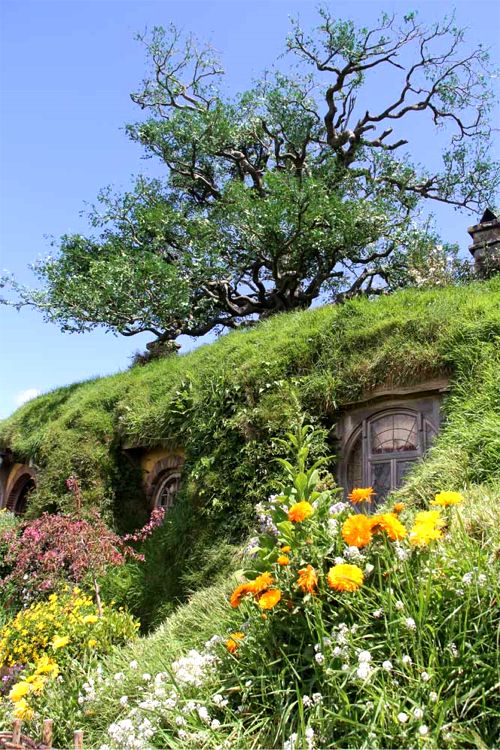
Fun facts: Since there was not one at the perfect location on site and in order to keep with the setting in the book, the oak tree supposed to be overlooking Bag End had to be cut down and brought in from near Matamata. Each branch was numbered and chopped, then transported and bolted together on top of Bag End (weighing 26 tonne). Artificial leaves were imported from Taiwan and individually wired onto the dead tree to look as natural as possible – overseen by Brian.
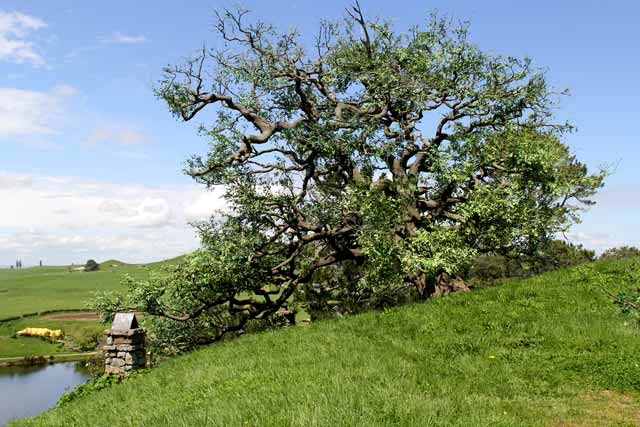
The reconstructed oak tree.
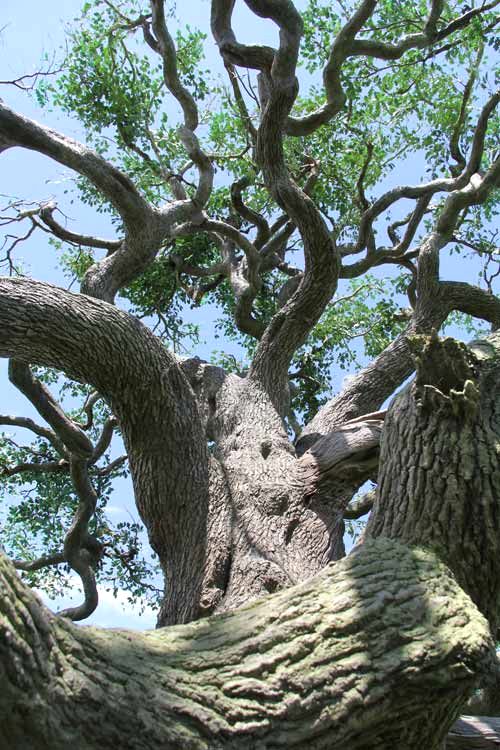
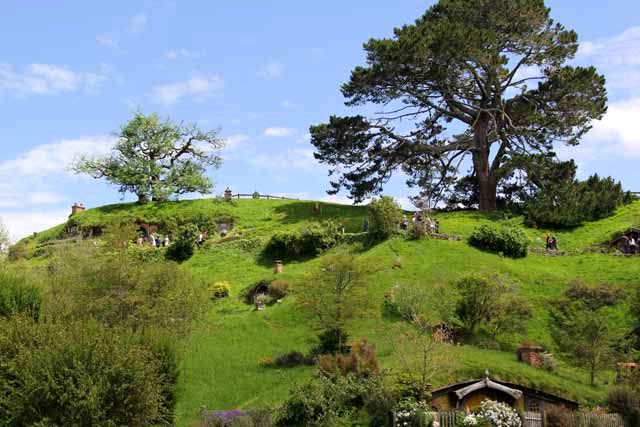
Close by but down a bit into a wide field where the festivities were held is the famous Party Tree, above right and below, a simply massive pine with awesome gnarly branches sweeping the ground and to the sky. I think it’s the biggest tree I’ve ever seen! As you may know, Bilbo’s Farewell Birthday Party was a great celebration held in honor of his 111th birthday as well as Frodo’s birthday and “Coming of Age.”
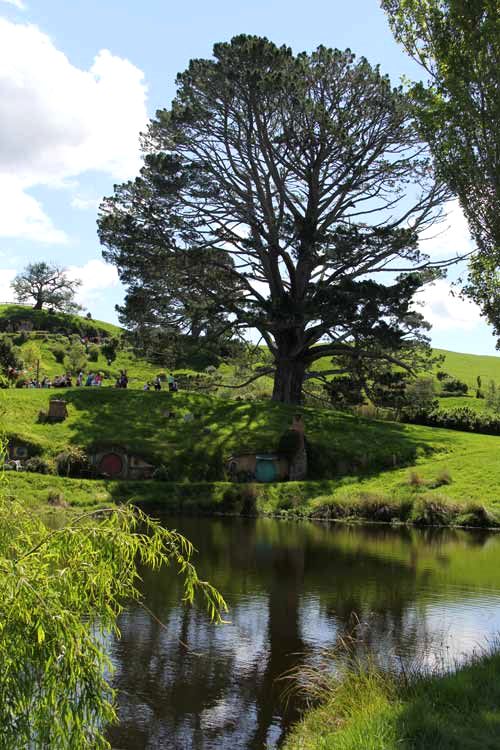
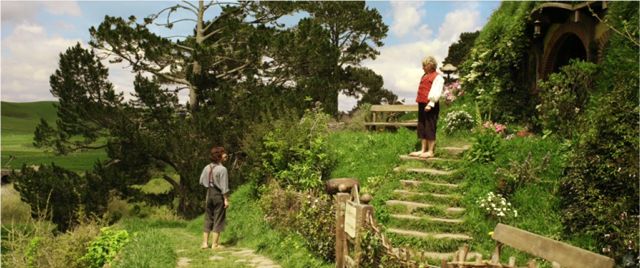
Frodo and Bilbo talking before the party takes place in The Fellowship of the Ring. Photo Source: Elvenesse.net
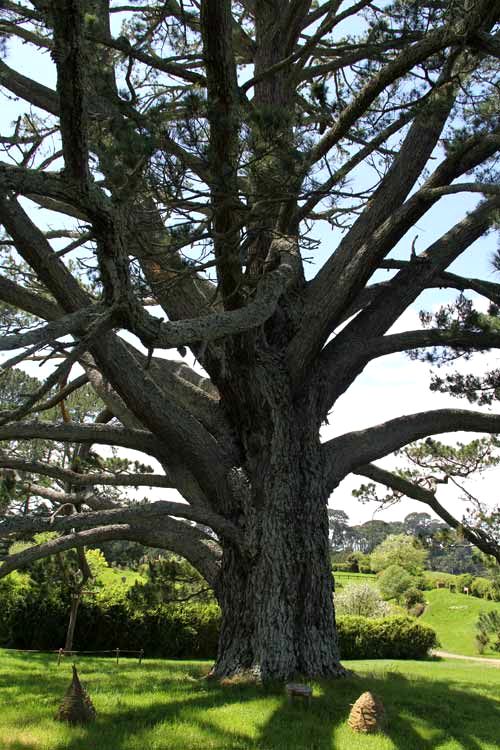
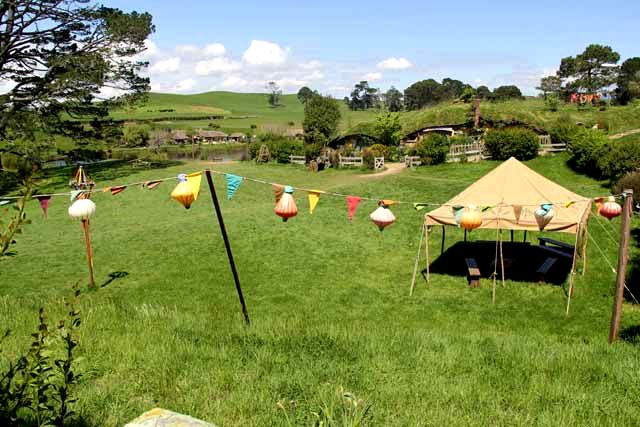
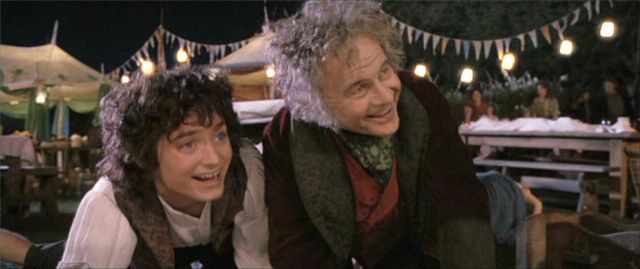
Frodo (Elijah Wood) and Bilbo (Ian Holm) Baggins at their party in The Lord of the Rings: The Fellowship of the Ring. Photo Source: Heirs of Durin ~ Thorin Oakenshield and Allies
“…eleventy-one years is too short a time to live among such excellent and admirable hobbits. I don’t know half of you half as well as I should like; and I like less than half of you half as well as you deserve.” ~ Says Bilbo to his guests at the party from The Lord of the Rings: The Fellowship of the Ring, J.R.R. Tolkien
As we walked through some woods and fields, we heard some faint singing. Opened in December 2012, the latest addition to the set is The Green Dragon Inn, a replica pub from the LOTR that serves custom-brewed beer and non-alcoholic ginger ale as well as such Hobbit fare as Beef & Ale Pie. (Previously it was just a much smaller empty front set.)
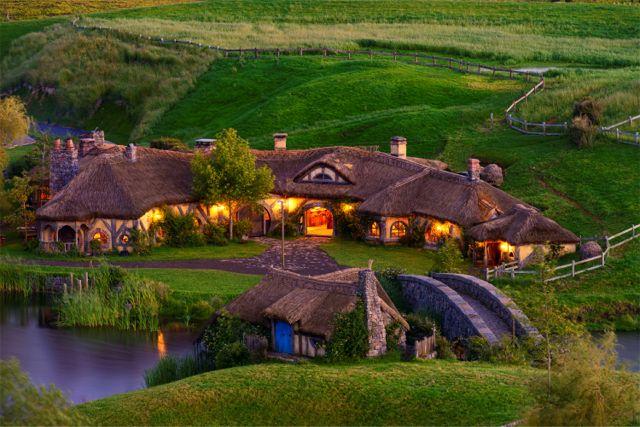
The Green Dragon with the stone mill and bridge in the foreground; Photo Source: Hobbiton Tours
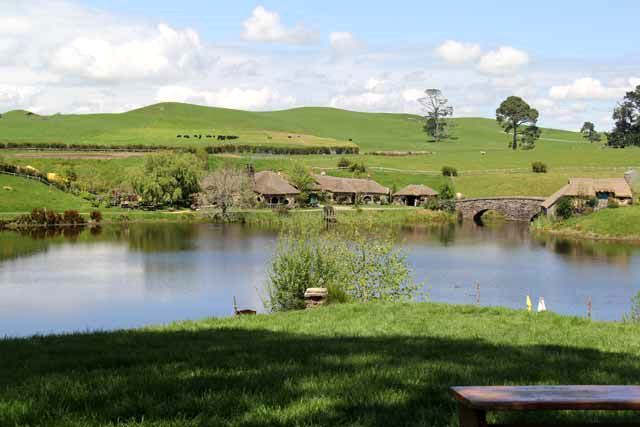
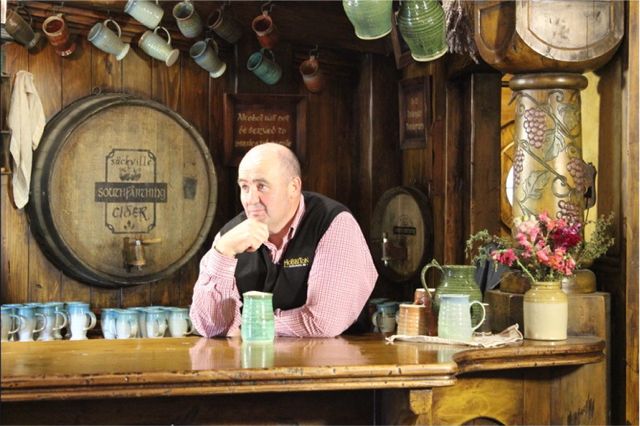
“Russell Alexander – ‘the squire’ of Hobbiton at home in The Green Dragon.” Credit: www.hobbitontours.com
Beautifully thatched and festively lighted on the outside, the woodwork inside is expertly done. Brian said Wingnut Films really wanted to keep it as authentic as possible and balked at having to put up such modern but necessary nuisances like emergency exit signs. Local codes won out but I don’t think they detract at all from the ambiance!
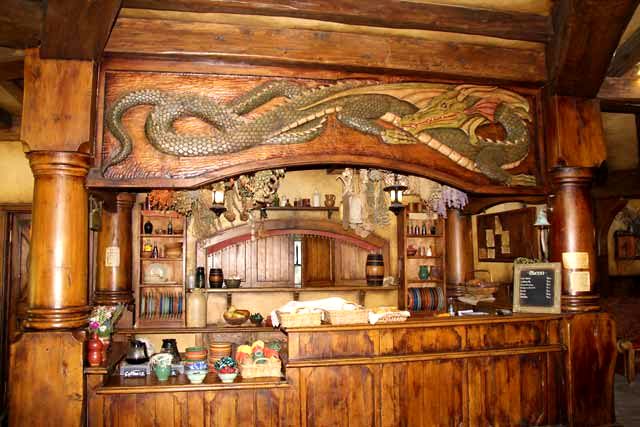
The actual green dragon inside The Green Dragon Inn
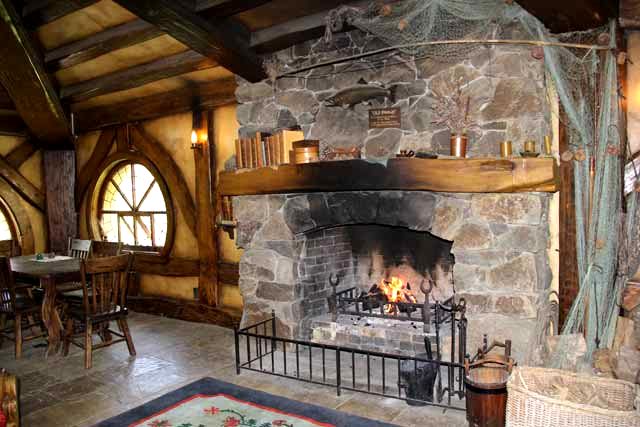
We ended our tour here and had a couple of pints of the exclusively crafted Southfarthing™ refreshments inside the handsomely crafted pub. Afterwards we went outside and sat under some delicate willow trees to really appreciate the The Green Dragon Inn grounds.
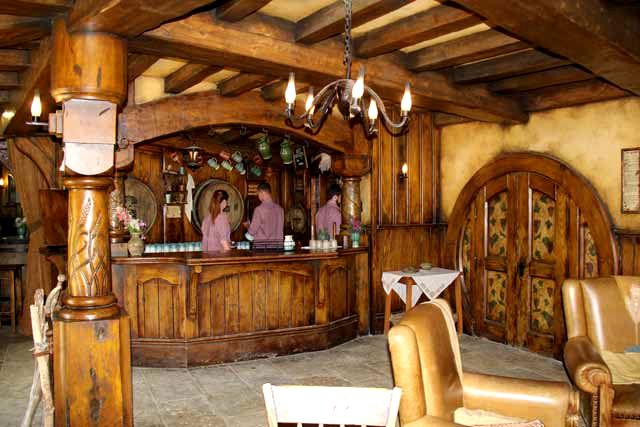
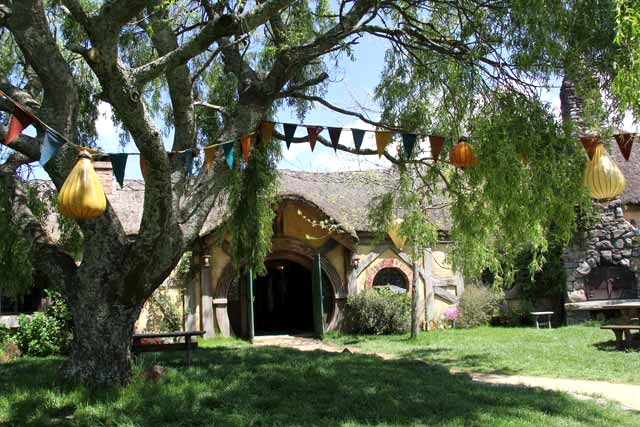
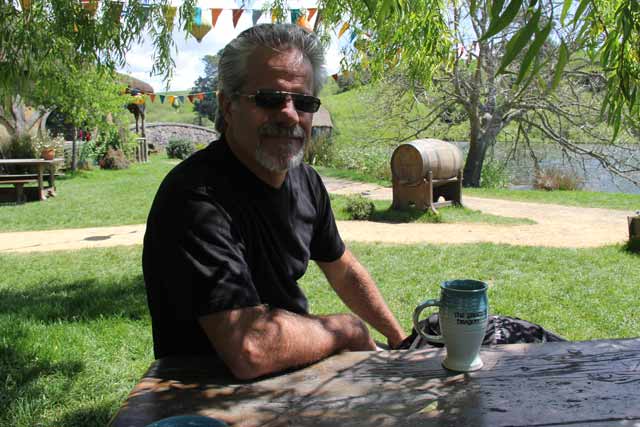
Aramis enjoying the ale and the beautiful day at The Green Dragon Inn at Hobbiton
They recently completed a pavilion open for private parties and functions – many corporate events have been held here as well as weddings – how cool.
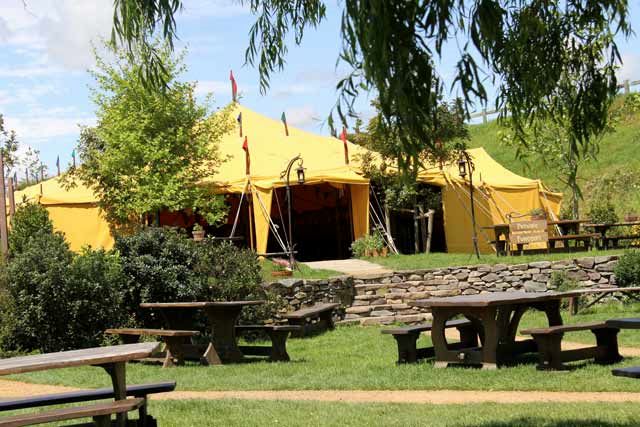
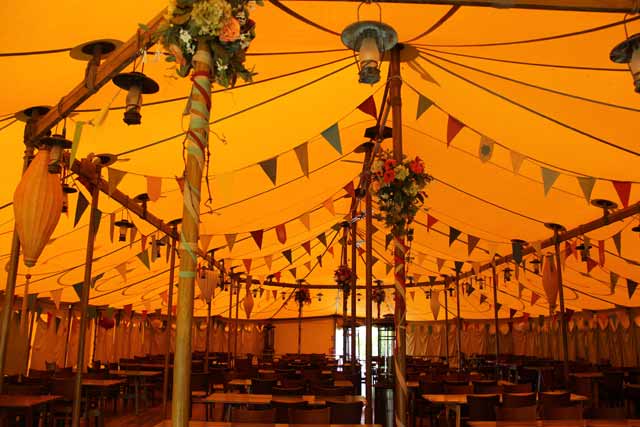
And then we just stayed for a while to contemplate the reflections off the beautiful lake.
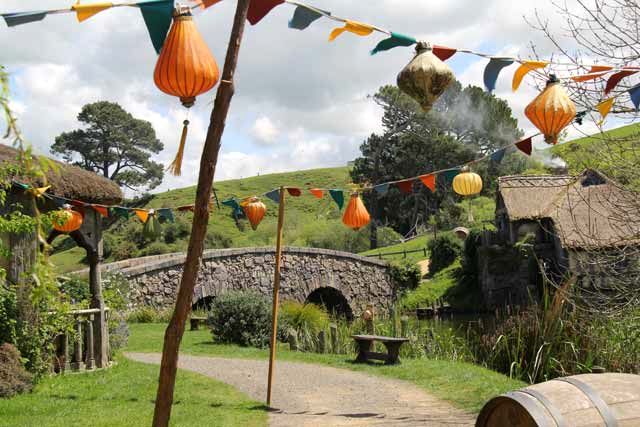
![]()
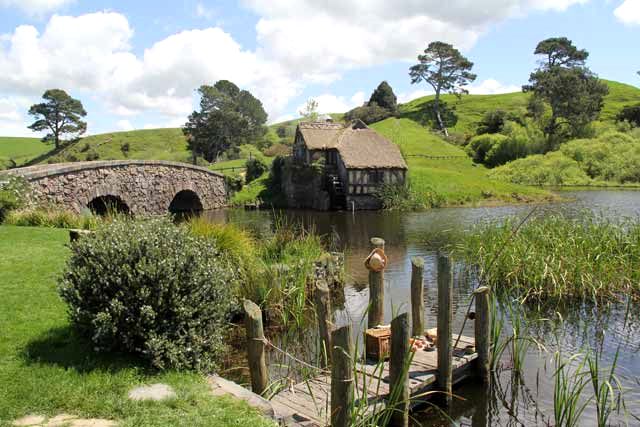
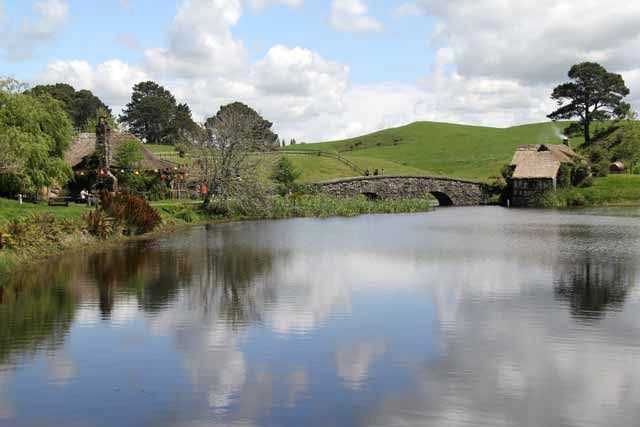
Finally, we were back trailing Brian’s truck rocking along the dirt country road through the many sheep paddocks to get us back to the parking lot. Just like other tourist attractions, Hobbiton does have a souvenir shop, The Shire™ Store situated below The Shires™ Rest Cafe – but located off the property to ensure a true realistic Hobbit environment experience for its visitors. Of course I bought some things – a T-shirt and a couple of books! (I should have bought the local lanolin creme, too, made here on the farm…)
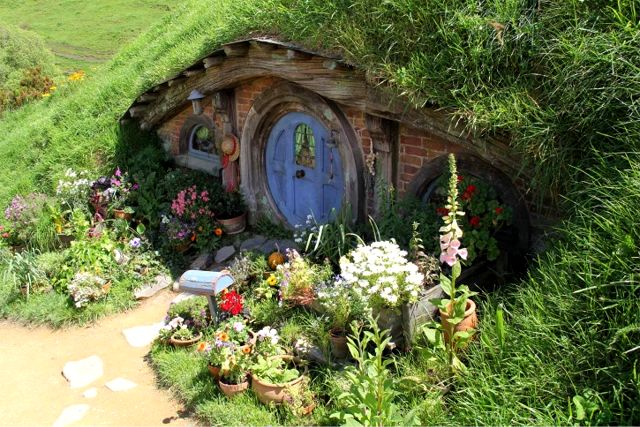
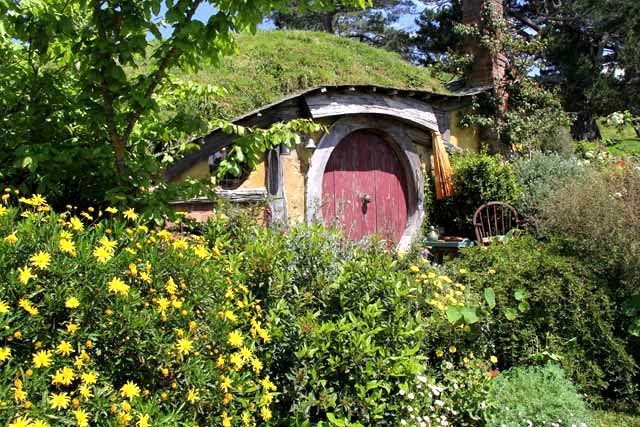
Hobbiton is not your typical tourist attraction – it is a leisurely, passive site with no rides, no characters in costumes, as simple and unassuming as the rosy-cheeked Hobbits themselves. At Hobbiton you will be immersed in the wavy green hills of the bucolic countryside alongside the gentle rolling Hobbit hole homes, envisioning Hobbit life here, perhaps even a visit from dwarves or the sage wizard Gandalf himself (portrayed by Sir Ian McKellen).
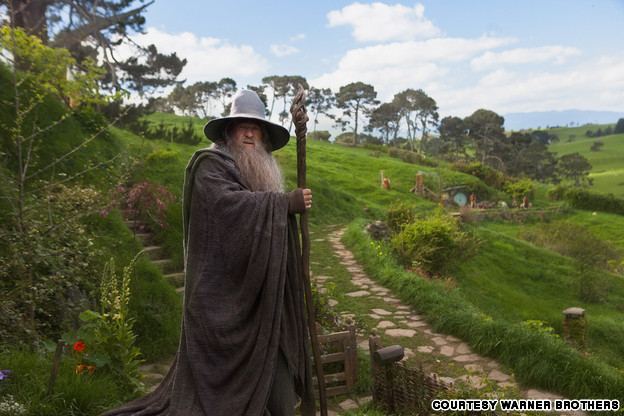
“The Hobbiton Movie Set, reconstructed for “The Hobbit” films and developed as a tourism park by Sir Peter Jackson and the Alexander Family (the original farm owners), is the most spectacular of all Middle-earth locations.” Via Breaking News USA; Photo Courtesy Warner Brothers
“A wizard is never late, nor is he early. He arrives precisely when he means to.” ~ The Lord of the Rings: The Fellowship of the Ring, J.R.R. Tolkien
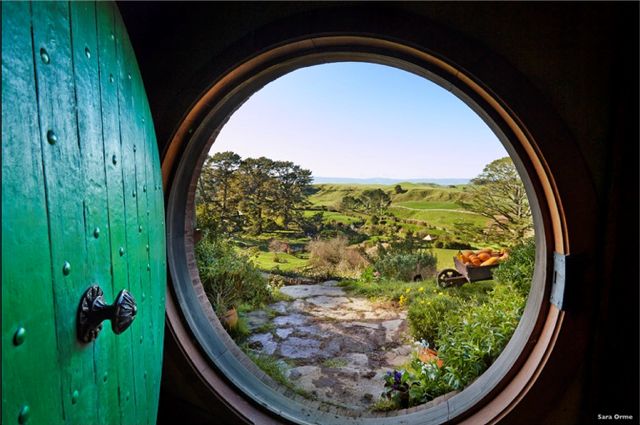
“Hobbiton Movie Set Tours – a Hobbit’s view of the film-star landscape that everyone can experience in Matamata.” Credit: Tourism New Zealand
A truly magical place to surrender yourself to moments of quiet reflection and thoughts of bygone eras and realms, Hobbiton, in my opinion, is a lovely example of understated grace in an era of rampant commercialism.
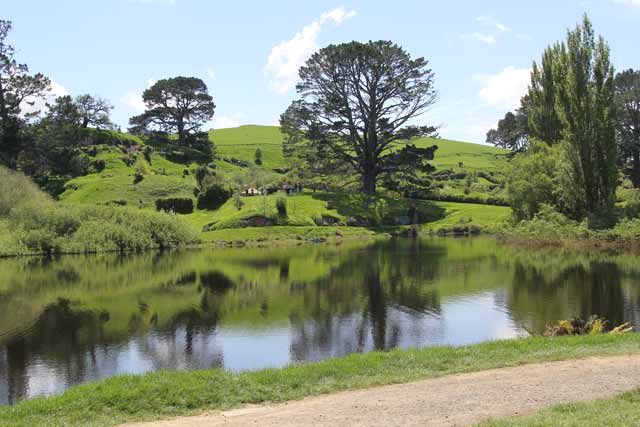
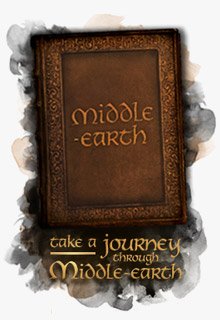
This beautiful piece of Waikato farmland was transformed into The Shire from Middle-earth by people with great respect for nature, and it’s being kept pristine, with great care obvious in every aspect of its daily operation. Located near the farming town of Matamata with spectacular views across to the Kaimai Ranges, the Hobbiton™ Movie Set is pretty easily accessible. The address is 501 Buckland Road, Hinuera, Matamata, New Zealand (+64 7-888 1505), and it’s a two-hour drive from Auckland and within easy access of other tourist destinations including Rotorua, Waitomo, Tauranga and the city of Hamilton. As you can imagine, I highly recommend the tour to everyone of all backgrounds and ages.
We were extremely privileged to have had Brian Massey lead us through Hobbiton for a good three hours and we greatly thank him and Graham Cleary again for their generosity of time and the beautiful once in a lifetime opportunity! You both really made my trip Down Under a spectacular one!
By the way, I found a 4-leaf clover here – pretty lucky!
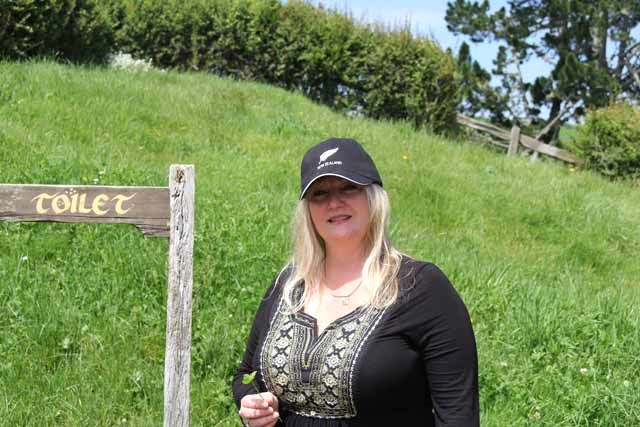
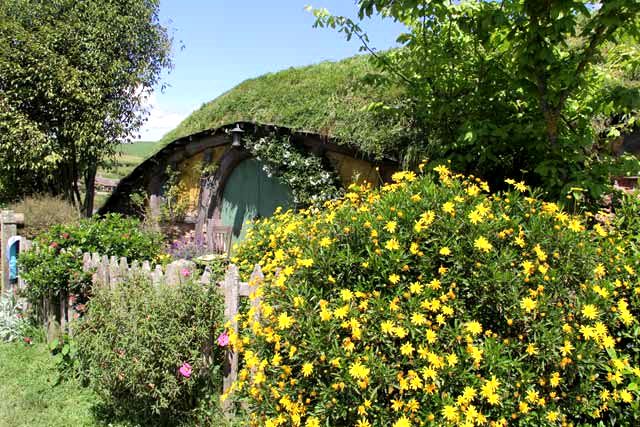
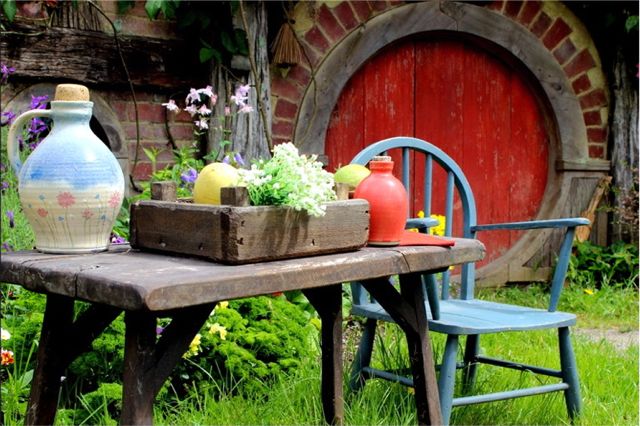
“A re-dressing of the Hobbiton Movie Tour set has added a real burst of colour and the chance to imagine life as a Hobbit.” Credit: www.hobbitontours.com/
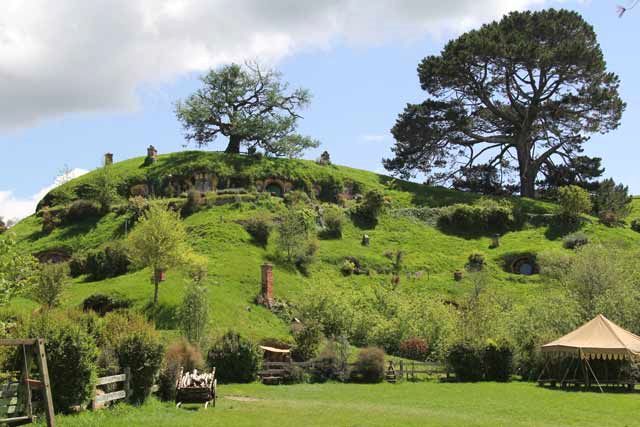
I can’t wait to go see the final movie in The Hobbit trilogy, The Battle of the Five Armies – currently the #1 movie in the world – but I have to watch the first two movies again – will do it very soon! See the trailer below:
Additional info:
Hobbiton Tours website – “Discover the Real Middle-earth”
Hobbiton Tours on Facebook
The Hobbit on Facebook
Lord of the Rings Trilogy on Facebook
Peter Jackson on Facebook
Hobbiton – from family farm to film fame from Tourism New Zealand
Tourism New Zealand website – “Home of Middle-earth”
Tourism New Zealand on Facebook
As the world prepares for ‘The Hobbit,’ New Zealand prepares for the world from Breaking News USA
TheOneRing.net – a website “forged by and for fans of JRR Tolkien”

Photo Source: Hobbiton Tours
The Hobbiton™ Movie Set is Greenroofs.com’s Project of the Week for December 29, 2014. See the project profile in The International Greenroof & Greenwall Projects Database.
So what if you don’t have a cozy little hill to nestle a Hobbit home into? You, too, could have your own Hobbit-like living roof house with a beautiful, standalone greenroofed abode. I’m sure hardcore Tolkien fans and the Hobbits would be proud of your sustainability efforts!
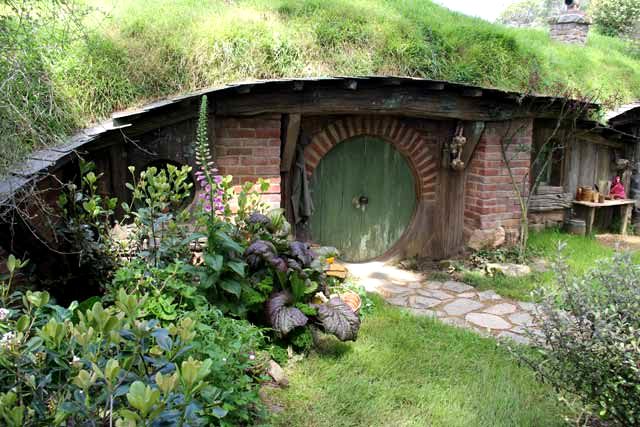
Happy Holidays from Middle-earth and all of us here at Greenroofs.com!
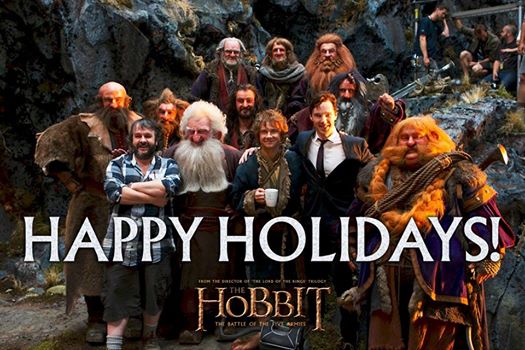
Courtesy of Wingnut Film Productions Limited
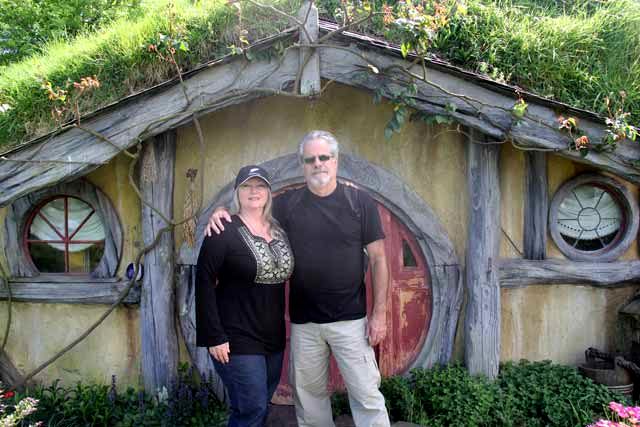
Aramis and I wish you very merry holidays and a fantastic New Year in 2015! Photo by Brian Massey
~ Linda V.
More photos – enjoy!
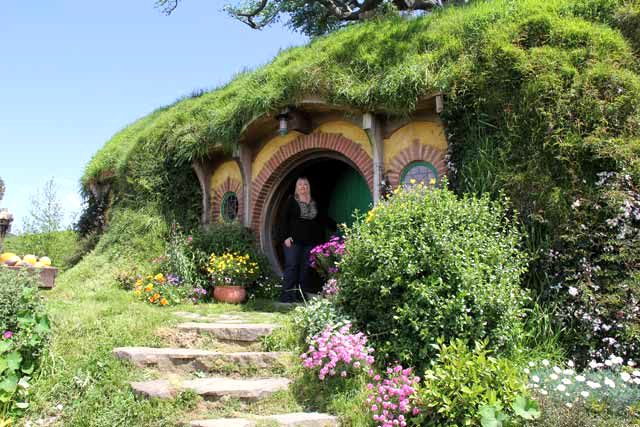
Linda at Hobbiton on 10.21.14; Photo by Aramis Velazquez
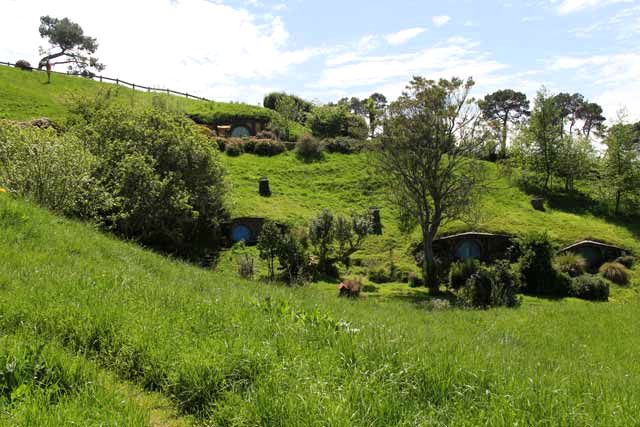
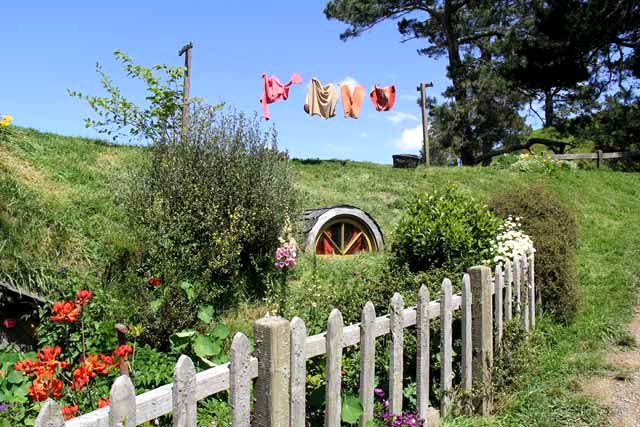
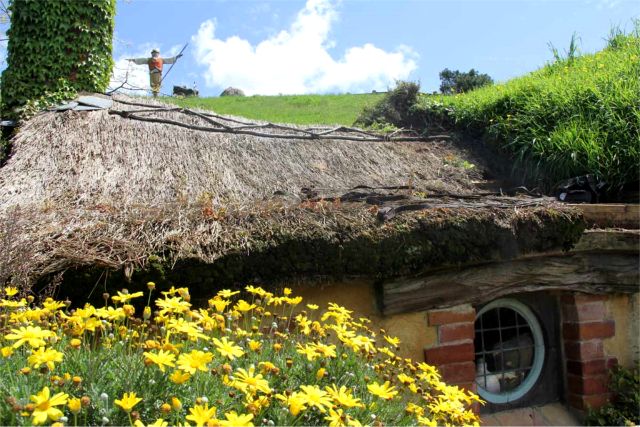
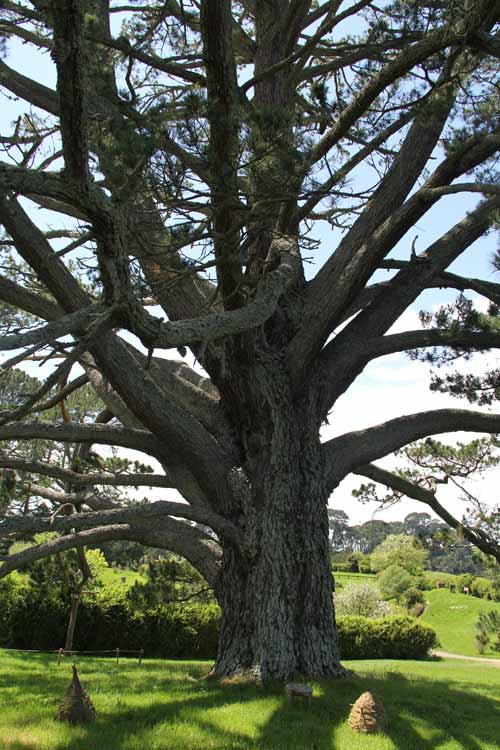
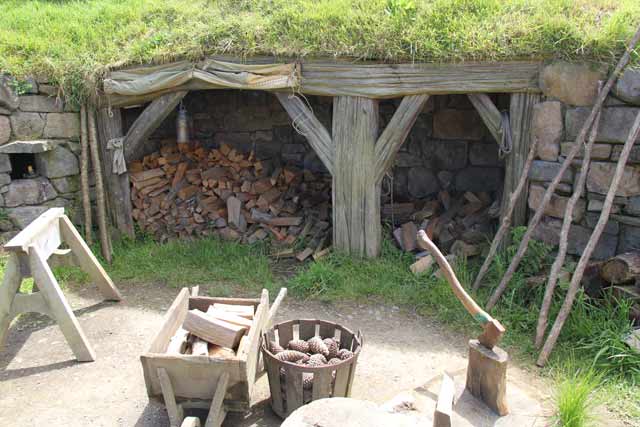
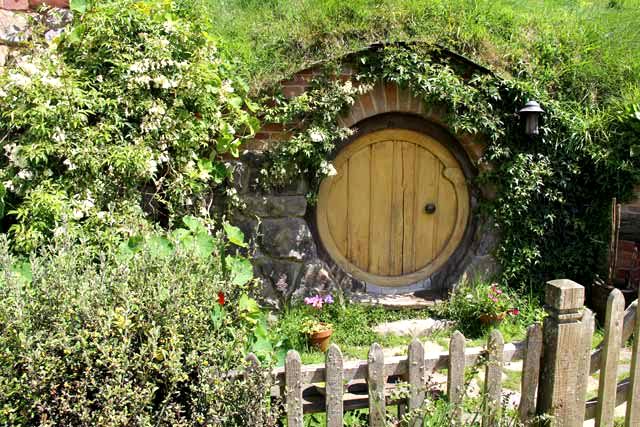
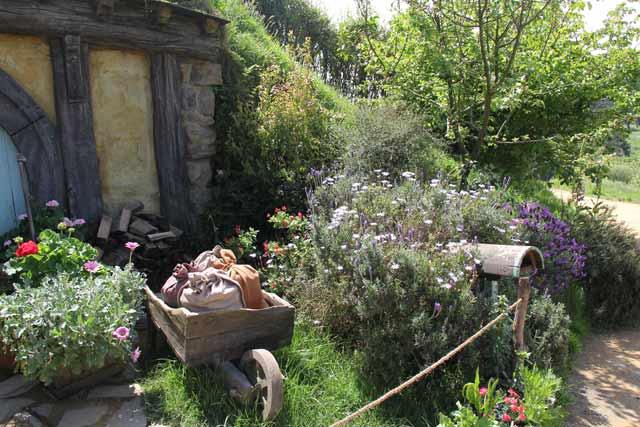
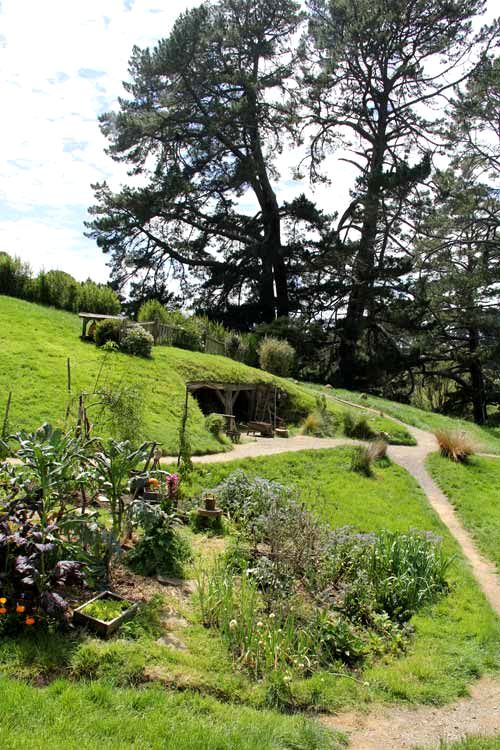
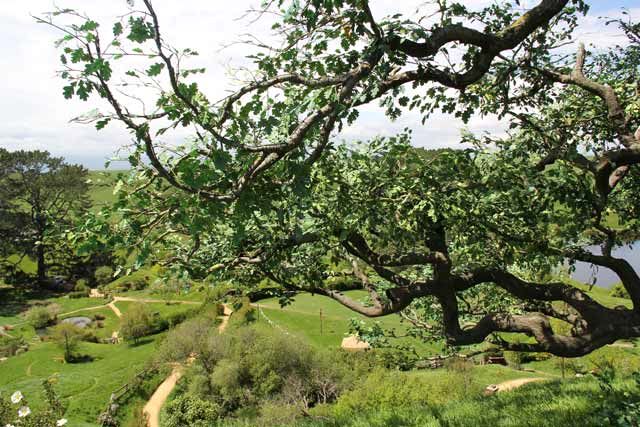
Reconstructed oak tree overlooking the hills
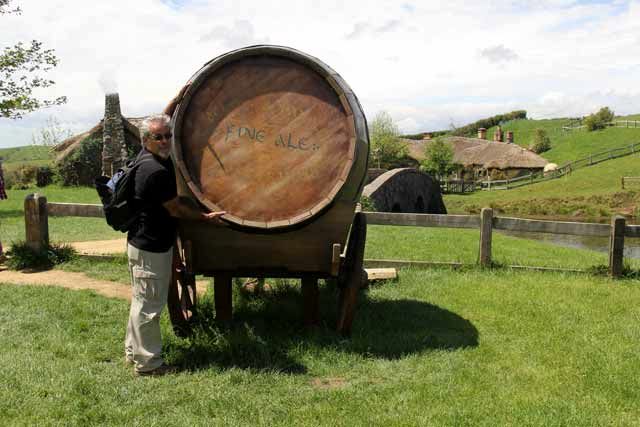
Aramis found the Hobbit Ale!
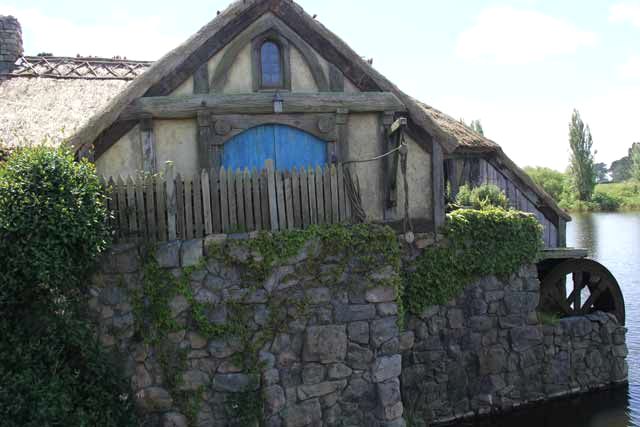
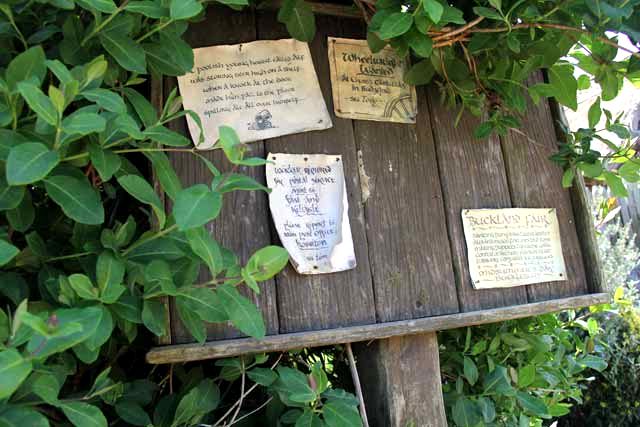
The attention to detail is found everywhere, even on a Hobbit bulletin board.
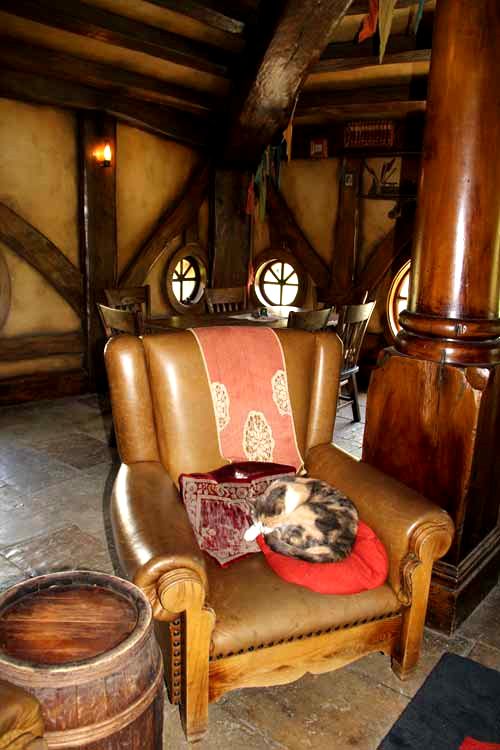
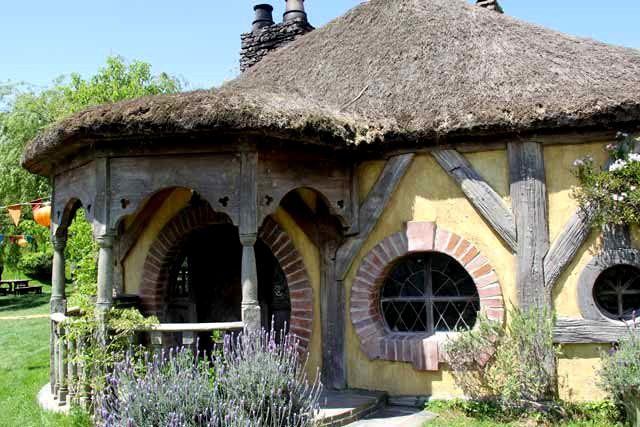
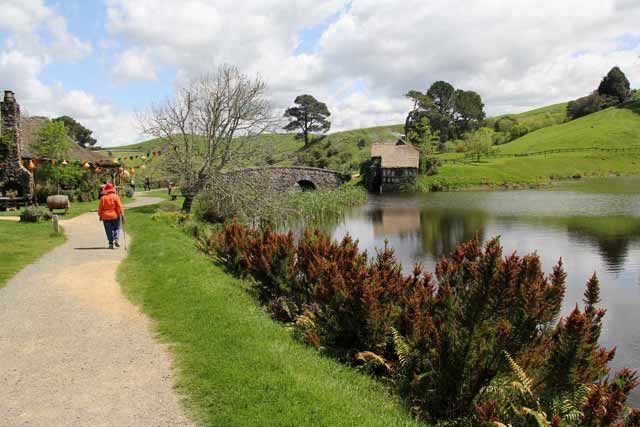
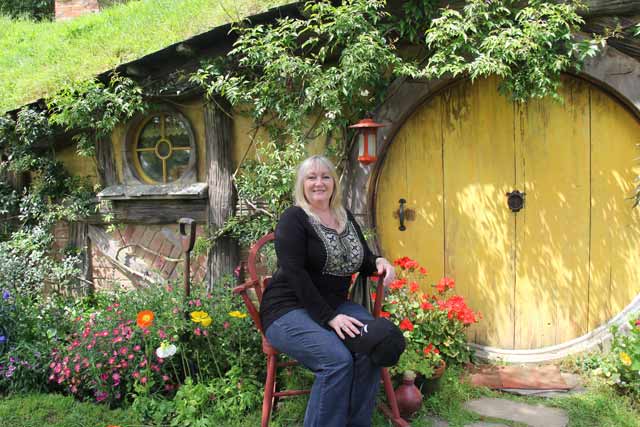
I really had the time of my life here at Hobbiton! Photo by Aramis Velazquez
 Greenroofs.comConnecting the Planet + Living Architecture
Greenroofs.comConnecting the Planet + Living Architecture

